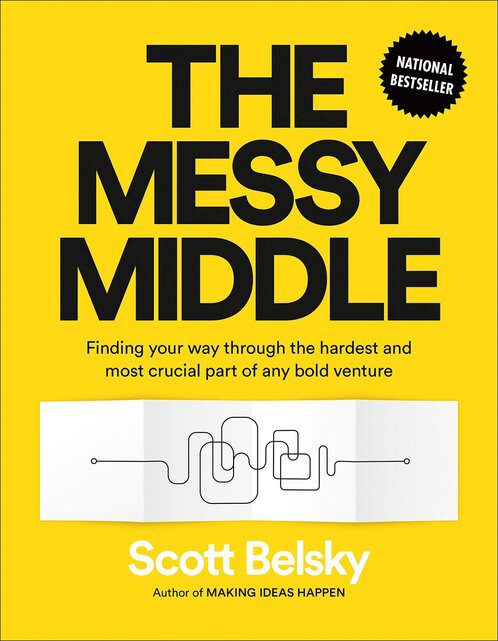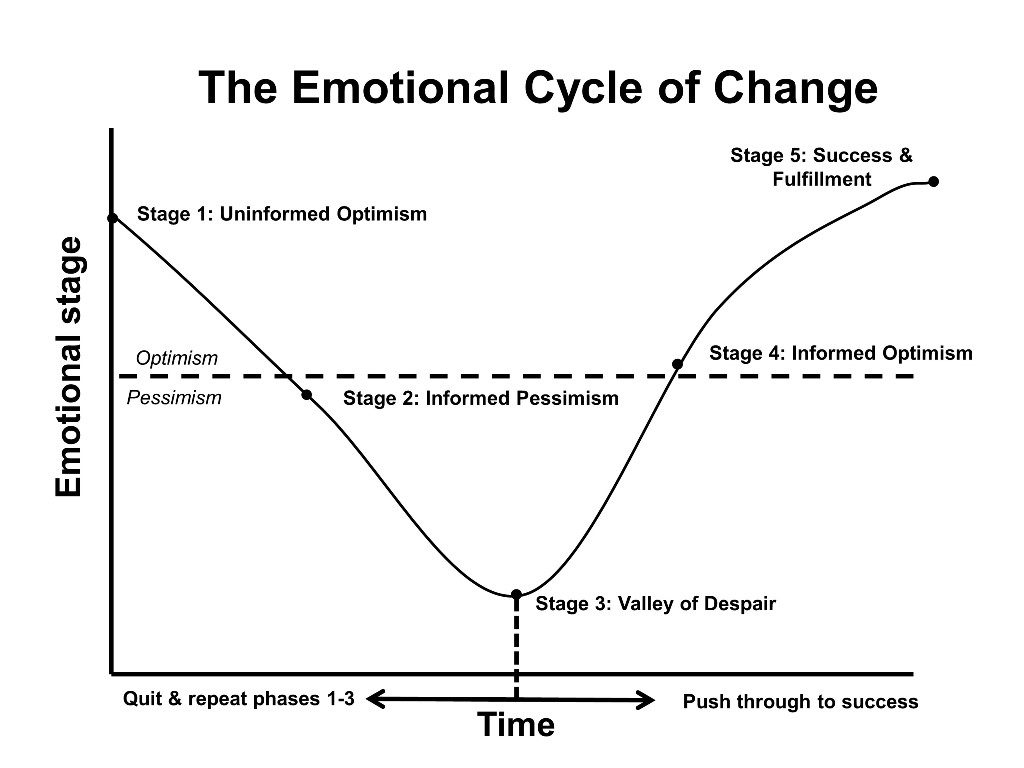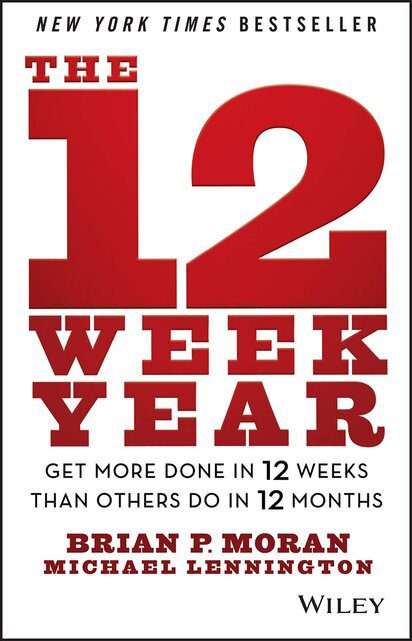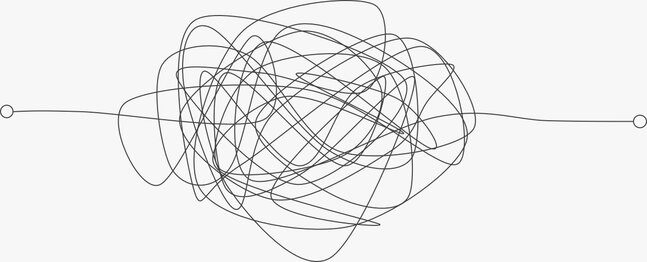The real test of your resolve for achieving your goals and aspirations lies in how you handle the tough and somewhat messy middle on your path to getting things done. When you first set a goal, especially New Year resolutions, it is set with much pump and enthusiasm. As we all eventually find out around mid-march, staying motivated all year round can be tough and challenging.
The Messy Middle shows up when the going gets tough like they often do, when you don’t feel like getting up from bed, not wanting to go to the gym because of bad weather, not reading the book because you are tired, dropping out of the online course or programming class because it is getting tougher, stopping swim class because you are not really seeing the progress. The Messy Middle can be a good excuse to stop but it is when you need to remember why you started or set the goal in the first place.

The Messy Middle
As co-founder of Behance, Scott Belsky noted in his book, The Messy Middle: Finding Your Way Through the Hardest and Most Crucial Part of Any Bold Venture “The Middle of the journey is all about the valleys and optimizing the peaks”.

Belsky observed
While we love talking about starts and finishes, the middle miles are more important, seldom discussed, and wildly misunderstood.
You survive the middle by enduring the valleys, and you thrive by optimizing the peaks. You will find your way only by reconciling what you learn from others with what you discover on your own. You’ll get lost. At times, you’ll lose hope. But if you stay curious and self-aware, your intuition and conviction will be your compass.
You’ll get lost. At times, you’ll lose hope. But if you stay curious and self-aware, your intuition and conviction will be your compass.
While difficult to withstand and tempting to rush, the middle contains all the discoveries that build your capacity. The middle is messy, but it yields the unexpected bounty that makes all the difference.
The middle is messy, but it yields the unexpected bounty that makes all the difference.
In reality, the middle is extraordinarily volatile—a continual sequence of ups and downs, expansions and contractions. Once the honeymoon period of starting a new journey dissipates, reality hits you. Hard. You feel lost and then you find a new direction; you make progress and then you stumble.
The Emotional Cycle of Change
Psychologist Don Kelley and Daryl Conner presented their Emotional Cycle of Change model in which they developed a model of voluntary change as outlined in the “1979 Annual Handbook of Group Facilitators.
The Emotional Cycle of Change comprises of five stages:
- Stage 1: Uninformed optimism.
- Stage 2: Informed pessimism.
- Stage 3: Hopeful realism.
- Stage 4: Informed optimism.
- Stage 5: Completion.

In their book, The 12 Week Year: Get More Done in 12 Weeks than Others Do in 12 Months, authors Brian P. Moran and Michael Lennington describe the Emotional Cycle of Change:

Whenever we decide to make a change in our lives, we experience an emotional roller coaster. Psychologists Don Kelley and Daryl Connor describe this phenomenon in a paper called “The Emotional Cycle of Change.” Kelley and Connor’s emotional cycle of change (ECOC) includes five stages of emotional experience.
The ECOC is the description of the emotional impact of change. By being aware of this cycle, you are less likely to be derailed by negative emotions and are able to manage change more effectively.
There are five stages that people move through emotionally when changing their behavior:
I. Uninformed Optimism
II. Informed Pessimism
III. Valley of Despair
IV. Informed Optimism
V. Success and Fulfillment
Regardless of the change you choose to make, you will experience this cycle. You can plot new relationships, new purchases, new jobs, and new neighborhoods on the ECOC, and it’s always the same.
Sometimes the highs are higher, and sometimes the lows are lower; sometimes the cycle is shorter, and other times it’s longer, but in all cases, you will experience this cycle when you decide to make a change in your life.
Uninformed Optimism
The first stage of change is most often exciting, as we imagine all of the benefits and have not yet experienced any of the costs. Our emotions are driven by our uninformed optimism, which is in the positive emotional area of the graph. You see all of the benefits of the change and none of the downside, so this stage is fun. You are brainstorming ideas and strategizing how you might create the new level of results that you desire.
“Unfortunately, uninformed optimism doesn’t last long. As you learn more about the reality of what it takes to change, positive emotions can quickly sour.”
Informed Pessimism
This stage is characterized by a shift to a negative emotional state. At this point, the benefits don’t seem as real, important, or immediate, and the costs of the change are apparent. You start to question if the change is really worth the effort and begin to look for reasons to abandon the effort. If that’s not bad enough, things get worse.
Valley of Despair
This is when most people give up. All of the pain of change is felt and the benefits seem far away or less important—and there is a fast, easy way to end the discomfort: Going back to the way you used to do things. After all, you rationalize that it wasn’t so bad before. If you quit on change when you are in the valley of despair, you go back to the first stage, uninformed optimism, which is a whole lot more fun than being in the valley!
It is precisely at this stage—the valley of despair—that having a compelling vision is critical. Nearly all of us have had times in our lives when we wanted something so badly we were willing to pay any price and overcome any hurdle to get it. Wanting passionately to reach your vision, combined with commitment and the tools and events of process control, is the way through the valley to the next stage of change.
Informed Optimism
At this stage, your likelihood of success is much higher. You are back in the positive emotional area of the cycle. The benefits of your actions are starting to bear fruit and the costs of change are lessened because your new thoughts and actions are becoming more routine. The key at this stage is to not stop!
Completion
At this final stage of change, the benefits of your new behaviors are fully experienced and the costs of change are virtually gone. The actions, which at the beginning were difficult and uncomfortable, have now become routine. Every time you complete the cycle, you build not only your capacity, but also your confidence.
At this point, you can move on to the next change that you want to implement with greater assurance of success
As “The Emotional Cycle of Change” shows: achieving any worthwhile goal is a roller coaster of ups and downs, peaks and valleys, enthusiastic beginning, messy middle and triumphant ending. Getting things done and achieving your goals involves understanding the seasons of life, the cycle of change and the impermanence of everything.
Success is the progressive realization of a worthy goal. – Earl Nightingale

Anyone can set a goal for example to read 100 books in a year. Since 2016, I have been setting a goal of reading 100 books per year and have tried to achieve the goal consistently. It has not been easy executing on a stretch goal such as the 100 books challenge.
The middle of achieving the goal yearly is always messy but when the messy middle occurs, here are some strategies that have helped me navigate the storm:
- Starting with Why
- Setting SMART Goals
- Reviewing my goal continuously
- Accountability through this blog | 2020 | 2021 | 2022
- Taking it a step at time through daily small wins
- Having self-compassion
Hitting the Wall
The Valley of despair is synonymous with hitting the wall, experienced in endurance sports such as long-distance running. As someone that has participated in 10+ Marathons, I can relate to the fatigue and loss of energy experienced while running a marathon. You feel exhausted, spent, you feel like giving up, imagine feeling your legs cannot move at 21 KM when you still have another 21 KM to run.
It is usually exhausting, I have been there a couple of times. At this moments, every step is a victory, every push to the finish is the reward. In the same manner, the messy middle is rough and tough but with willpower, grit, persistence and consistency; you would pull through.
The valley of despair is a terrifying place to be as you want to really give up, you are gasping for air, running in pain, the web traffic is not increasing, the funds are running low, the bills keep pilling, and quitting looks like the easiest way out. You’ve got this, you have to see the end in mind, keep moving and everything would align in the end.
All the Best in your quest to get Better. Don’t Settle: Live with Passion.



Comments are closed.